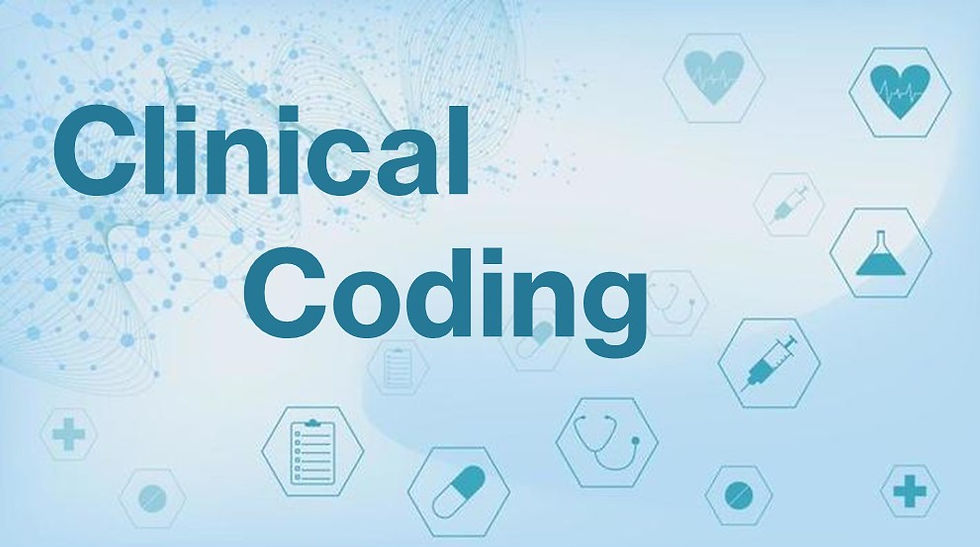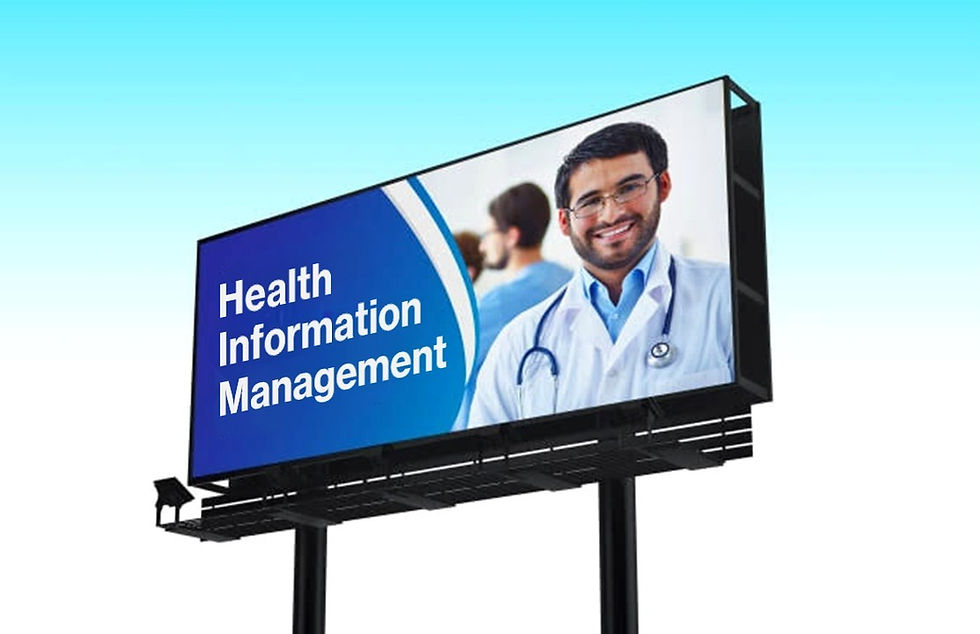Clinical Coding: A Migration to ICD-11
- Siphosami Ndala
- Aug 5
- 5 min read
What is Clinical Coding?
Clinical Coding, also known as medical coding, is a health information management process in which health professionals, known as clinical or medical coders, translate clinical documentation or clinical data into codes. This system ensures a global form of uniformity within our healthcare spectrum. Clinical coding is universally and mandatorily used to translate patient conditions (diagnoses) and other health-related issues into alphanumeric codes called ICD-10, which is the World Health Organization’s system of medical classification, International Classification of Disease 10th Edition. In the US, the medical classification used is ICD-10-CM, which has more clinical extensions than the base ICD-10 codes. Prior to the development of iCD-10, the World Health Organization (WHO) had ICD-9-CM in place.
When it comes to procedural coding, the American Medical Association developed the Current Procedural Terminology (CPT) system which translates the procedures or surgeries undertaken on patients into codes, including clinician consultation codes (Evaluation & Management) and Anesthesia codes, thus assisting in proper communication and reimbursement on the extent or scope of clinical input a provider has invested at each encounter. In the US, clinical coding also expands to HCPCS Level II codes (Healthcare Common Procedure Coding System) which are alphanumeric codes allocated to identifying medical devices, supplies, medications and other services.
With our health system continually in an ever-changing continuum, from an etiology perspective to a technological advancement viewpoint, it is only inevitable that our clinical processes evolve over time as well. For this reason, clinical coding, both ICD-10 and CPT codes, are updated annually to accommodate new conditions and new procedures that may need specific reporting.

Migration to ICD-11
Having championed ICD-10 for a decade now, the World Health Organization has introduced a new coding system, ICD-11 (International Classification of Disease 11th Edition), which is geared towards making improvements in the accuracy and preciseness of diagnostic coding. ICD-11 was released and effected in 2022. As at 2023, over 50 countries were reported to have implemented transition phases from ICD-10 to ICD-11. Here are the main features of ICD-11 and why it is a logical migration to embrace.
More Detailed and Comprehensive: In comparison to ICD-10, ICD-11 has been created to be more comprehensive in its nature, encompassing a wider range of conditions with more details applied for specificity, making it far more efficient than ICD-10.
Contemporary Clinical Updates: Due to an evolving health system, ICD-11 has made big strides in closing clinical coding gaps in our health space as we know it today. It has incorporated modern-day clinical language and practices. Much coding from ICD-10 is not reflective of the fluctuating nature of our present-day health complexities, nor does it provide much room for additions or updates to existing codes.
Digital Compatibility: Another impressive feature of ICD-11 is how it is structured for digital use and created to be compatible with Electronic Health Record (EHR) systems and other health information management systems. ICD-11 has been created to aptly accommodate the contemporariness of our technological developments into digital spaces.
Greater Code Options: ICD-11 has almost four times more code options than ICD-10. With over 50 000 codes, ICD-11 provides the coding field fair game for strengthening code quality and validity. Mental conditions that were not appropriately structured into ICD-10 are now consummated into ICD-11, covering their holistic clinical intricacies. The globality of ICD-11 means that it is very inclusive culturally and thus comes with greater standardization and interoperability.

Why is Clinical Coding so important?
Clinical Accuracy: Clinical coding can be viewed as a clinical way of communication that creates uniformity and clarity of patients’ conditions on a universal level. Coding paints a holistic picture of a patient’s condition, severity, comorbidity, personal and family medical and social history, as well as all tests and procedures conducted during their hospital stay. Coding accuracy is heavily reliant on the accuracy and availability of complete clinical documentation provided mainly by physicians. The more complete and specific the clinical documentation is, the more accurate and specific the coding can be.
Billing Efficiency: With accurate coding comes accurate billing. Coding and billing go hand in hand. By taking extra care in correctly assigning codes as specific as possible while adhering to guidelines, billing processes become a breeze. By streamlining the billing process, healthcare organizations can maximize their efficiency in addition to maintaining a healthy revenue cycle whilst empowering themselves to sustain and capacitate their healthcare delivery function.
Confidentiality of Personal Information (PI): Another very important factor to clinical coding is how it manages to ensure patient confidentiality. Health information is one of the most sensitive personal data known, and how this information is handled brings to light various global legislatures with the strict intent to protect and secure such information. Clinical coding aids in making certain that patients’ health information stays private and only accessed by those authorized to it. Because clinical coding is a unique clinical language, not many people are privy to it, this alone creating a sensible umbrella for clinical data protection.
Reliable Health Data Statistics: Clinical coding plays a huge role in the collection of health data for statistical purposes. It is rarely viewed as a crucial tool in the healthcare data analytics environment, and yet, to a bigger extent, clinical coding is the basis for health data translation in the managed healthcare domain. For health departments to work on health data on a broader scale, clinical coding assists in efficient data management processing. This includes collection, translation and interpretation, organizing and compliance validation, capturing and processing, to auditing and quality assurance of health data in coding form. In order for health policies and legislations to be effectively implemented, health departments rely on the validity of health data so as to strategically support health outcomes. By providing accurate clinical coding data, health departments possess reliable data sources from which they can make well-rounded informed decisions, equipping them to strengthen national and global systems to treat and manage disease.
Health Research Endeavors: With so many health challenges faced by our industry today, there remains a huge obligation on health institutions to discover and advance clinical management of disease. The duty to improve the quality of life on a global scale has seen numerous advances in drug trials, lifestyle change alternatives and mental health breakthroughs. By having an accurate and reliable clinical database through coding, research institutions can prioritize their focus based on which areas of healthcare are putting greater strain on their health systems and which advancements would relieve it. This provides strategic planning and prioritization for health focus based on accurate health perspectives.
Migration to ICD-11 is undoubtedly a huge part of healthcare quality improvement. Better coding quality imposes a direct impact on patient care quality which is an ethical duty to all healthcare leaders and providers. However, a responsibility remains in our healthcare systems to prioritize the most pivotal tool to ensure coding quality success…Clinical Documentation Improvement (CDI). Without a proper CDI program, clinical coding will remain ever challenged.

REFERENCES
Collins, S. (2024). 7 Key Strategies to Improve Medical Coding Accuracy. Available at: https://www.invensis.net/blog/strategies-to-improve-medical-coding-accuracy (Accessed on: 10/07/2025)
AMBNJ. (2024) Mastering ICD-10 Coding: Tips for Accuracy and Efficiency. Available at: https://ambnj.com/mastering-icd-10-coding-tips-for-accuracy-and-efficiency/ (Accessed on: 10/07/2025)
Singh, N. (2023) What is Data Management? A Complete Guide with Examples & Benefits. Available at: https://www.pickl.ai/blog/data-management-guide/ (Accessed on: 10/07/2025)
Daniel. (2024) What is Healthcare Data Analytics? Available at: https://datascientest.com/en/all-about-healthcare-data-analytics (Accessed on: 11/07/2025)
Keele, J. (2023) ICD-10 to ICD-11: Key Differences and What They Mean for Medical Coding in 2023. Available at: https://www.drbillingservice.com/blog/icd-10-to-icd-11-key-differences-and-what-they-mean-for-medical-coding-in-2023/ (Accessed on: 11/07/2025)
Andrews, M. (2024) ICD-11 vs. ICD-10: Understanding the Key Differences. Available at: https://www.nurse.com/nursing-resources/icd-10-codes/icd-11-vs-icd10/ (Accessed on: 11/07/2025)
Assessed and Endorsed by the MedReport Medical Review Board






